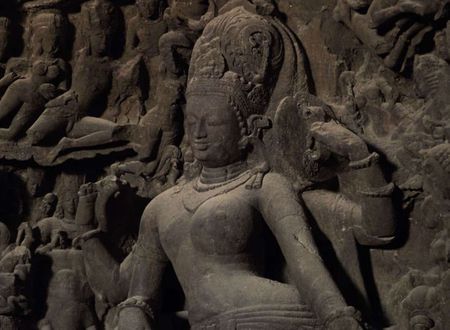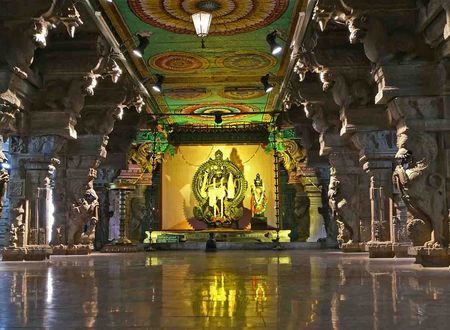A group of devotees including me have gathered together in a Scripture Study group which is currently studying the Srimad Bhagavad Gita as part of our Swadhyaya. A few conversations with some youngsters on the practice of Yagna and some curious queries by some members of the study group inspired me to share my brief research and limited understanding on the subject of Yagna, its significance and its concept in the Srimad Bhagavad-Gita studies which we have taken up. In an age where these practices and Vedic way of life is swiftly dwindling, I make this humble attempt by way of these series of posts split into three parts to avoid compromising on the content for the sake of brevity. This is only to share this knowledge as a small offering in the Sacred Gyana Yagya of scriptural reading of our ancient Sanatan texts to inspire all those who spend their valuable time reading it to take up this practice in its true sense.
Part 1 deals with the concept of Yagna and its importance and what can we do to inculcate the true spirit of Yagna
Part 2 deals with the significance of Homa (Agni karya) as an intergral part of Sadhana
Part 3 deals with the meaning of Yagna in light of Sri Lalitha and Vishnu Sahasranama
Concept of Yagya and its Importance
Yagna is a very important concept with a vidhi (procedure) in the yogic way of life of the Vedic age. People lived in the spirit of Yagna, that’s why in the Srimad Bhagavad-Gita you will find Lord Krishna telling Arjuna again and again that work done in the spirit of Yagna is detached action. It will lead you to the Highest.
So what is this spirit of Yagna? What is the concept behind Yagna – the actual fire sacrifice as it is called? What was it symbolic of?
Yagna comes from the dhatu or root word yaj which itself means to sacrifice or to pour out to or pour oblations into the sacred sacrificial fire. What is seen as Yagna in some form today is the Homa or Havan which is performed even in homes as a modern version of the Vedic Yagnas.
What is the meaning of this Yagna?
In the Vedic age there were no temples as they are today. Temples were built in the post Vedic age, but back then in that age, the Rishis understood certain basic principles of universal life and they converted that into symbolic means of performing certain rites so as to internalize and bring into our everyday lives those cosmic principles of life. This is how Yagna was born and the Rishis understood that the very nature of life is one unitary whole and the expression of life is interconnected, so in order to reinforce this idea into us they invented the great symbolism of the Yagnic fire. One pours oblations into the Yagna fire of things which one has grown like for example grains, ghee, seeds like sesame, sandalwood and so on. So all these oblations are poured as an offering to the supreme lord and the fire is supposed to be the vahni – the carrier of these offerings or oblations to the supreme. Yagna is the pillar of collective Indic Vedic culture which upholds the sanctity of the Vedas. Yagna is mostly considered as a ceremony incurring several steps. This is merely the physical aspect of Yagna in which after initial rituals and mantra chanting herbs are offered to fire as sacrifice. The physical process in itself is beneficial in several aspects for individuals, the environment and all sentient beings. However, the significance of Yagna is not restricted to this sacrificial fire-process. It has a much wider philosophy and deeper meaning. Ancient scriptures emphasize more onto subtle learning embedded within the rite and give an insight within the Yagna based life-style associated with it. The continuum of Yagna is the nucleus of continuous activities in the world and the cosmic expansion. Atharvaveda 09/10/14 “Yagyao vishwavsya bhuvanasya nabhih”, Rigveda 01/164/36 “Ayam yagyo vishwavsya bhuvanasya nabhih” elucidates Yagna to be pivotal in the existence and sustenance of the cycle of nature. The creation of nature is an eternal Yagna. It is the genesis of the flourishing manifestation of nature. The sentiment of Yagna indwells in the ecological balance and harmonious activities of nature.
While offering the oblations (ahutis), the phrase ‘Idam-na-mama’ implies: ‘This is not mine, but it is for supreme power i.e. for universal welfare’. ‘Idam-na-mama’ signifies the central theme of Yagna. What nature has bestowed upon me and entrusted me as its custodian, I offer that and use it for universal good. Life lived in accordance with the lessons from Yagna, experience holistic and cohesive development of human consciousness. Nature teaches us ‘Idam-na-mama’ through its incessant unbreakable natural cycle of Yagna. The behaviour pattern of nature follows the spirit of Yagna. The ocean is generous and gives its water to the clouds and the clouds in turn, carry their precious load from one place to another and finally pour them down as rain. Rivers and streams emerge from the soil, fed by this rain and they flow steadily to drench the earth and quench the thirst of all beings, trees and fruits give themselves up for the good of others and flowers bloom to give joy to all beholders. Whatever functions are performed by the sun, moon, stars, wind etc. are not for themselves, but only for the welfare of others. Each part of body is constantly working not for its own sake, but for the well-being of the whole body. The entire cosmos is running in the spirit of Yagna. If this spirit of self-sacrifice is absent, then all the beauty and harmony of creation will turn into chaos and destruction. Rishis have said that Yagna is like the hub of the wheel of creation and if this hub breaks, then it is impossible for the wheels to move and the chariot to go ahead.[1][2]
Swamji talks about some acts as being spiritual and some religious here. He says any act which makes you feel elevated as a human being, makes you a more compassionate being, that gives you more strength and helps in the welfare of the society is a spiritual act. Anything which is strictly religious is a Dharmic act. These, however are not empty rituals. These practices are like knocking at the door of our consciousness to remind us of what are we are supposed to do and how are we to conduct ourselves. Havan is a kind of Yagna. Ya means that, Gyna means something that helps you know, so Yagna is that act which aids in knowing THAT supreme.
Hence, there are many types of Yagna.[3] Hosting guests and looking after them is Atithi Yagya. Bhojan or Eating and digestion of food is a yagna.
अहं वैश्वानरो भूत्वा प्राणिनां देहमाश्रित: |
प्राणापानसमायुक्त: पचाम्यन्नं चतुर्विधम् || 15.14||ahaṁ vaiśhvānaro bhūtvā prāṇināṁ deham āśhritaḥ
prāṇāpāna-samāyuktaḥ pachāmy annaṁ chatur-vidham
In Bhagavad Gita chapter 15, verse 14 Bhagavan says: “It is I who take the form of the fire of digestion in the stomachs of all living beings, and combine with the incoming and outgoing breaths, to digest and assimilate the four kinds of foods.”
Shree Krishna says that God exists inside all living beings as vaiśhvānara, meaning “fire of digestion,” which is ignited by the power of God. The Bṛihadāraṇyak Upaniṣhad has also stated:
ayam agnir vaiśhvānaro yo ’yam antaḥ puruṣhe
yenedam annaṁ achyate (5.9.1)
“God is the fire inside the stomach that enables living beings to digest food.”
Kalpa Sutras talk of various types of Yagnas:
- Paka Yagnas: —These Yagnas involve consecrating cooked items.
- Soma Yagnas: — Agnistoma, atyajnistoma, uktya, shodasi, vājapeya, atirātra, and aptoryama are the seven soma-Yagnas.
- Havir Yagnas: —These involve offering havish or oblations.
- Panca Mahā Yagnas: — The “five great Yagnas” or Mahāsattras.
- Bhuta Yagna: – Sacrifice to living beings (animals, birds, etc.)
- Manushya Yagna: — Sacrifice to fellow human beings
- Pitr Yagna: — Sacrifice to ancestors
- Deva-Yagna (Homa) : — Sacrifice to Gods
- Brahm-Yagna or Gyana Yagna : — Sacrifice to Brahman(ultimate reality) by way of systematic reading of the scriptures
- Veda vrātas: — They are four in number and done during Vedic education.
- Sixteen Yagnas performed during one-time samskāras spanning the entire human lifetime from garbhādhānā (conception) to antyeshti (last rites of consigning the dead body to fire).
Today we have this popular concept of Pancha Maha Yagnas whose source is again the Vedic Yagna. All these Yagnas have an external and an internal aspect, for example the Deva Yagna is the external aspect with an actual Homa lit with oblations poured to the Gods but the internal aspect of it is where you deeply pay homage to the divine forces in your life, so it’s a way of acknowledging the presence of divinity in your life and paying your obeisance to it. In Pitri Yagna again the popular external aspect is offering pindas to the pitras. Pitras are the ancestral souls who are responsible for the creation of your personality as it is today so the external aspect of this was again giving offerings in the form of pindadaan. Tarpan is a form of giving water offering to departed ancestors. These are the external aspects of this Yagna. The internal aspect is again acknowledging their contribution in your lives and respecting it for who you are today. All this brings a positive state of mind which is forever in gratitude. The external aspect of all Yagna is service activities(sewa) offered for the well being of mankind and the internal aspect is again the feeling of kinship – oneness with all humanity. This should be part and parcel of our mind-set and inculcated as sanskaras in our children. Today when we see all these divisive forces in the world we understand the importance of the spirit of Yagna and its relevance even more. Then the Rishi Yagna is performed when again you externally light a Homa fire and pour oblations to the great Rishis whose lineages have been responsible for our Gotra – family systems of today. We consider ourselves to be derived from that source so acknowledging this in the form of Yagna is the external aspect and the internal aspect was again the deep respect for their teachings and studying the scriptures systematically, methodically on an everyday basis so as to imbibe their knowledge and then the Bhuta Yagna is again serving all beings on earth it including animals and plants – feeling a sense of kinship, of a fellowship with every form of life including the inanimate forms you see. The Pancha Mahabhutas (5 basic elements – earth, water, fire, air and ether) are responsible for the creation of your own body. Your body is a collection of all these elements put together, so you have a natural kinship with nature, with prakriti, so acknowledging this while serving and literally worshiping all living beings by providing for them is the Vedic way of life. If we can do this, then it is an observance of this spirit of Yagna in our everyday lives. That is why these Panchamaha Yagnas were instituted but it is really unfortunate that many people are totally disconnected from this spirit in the modern world. The more we imbibe this, whether you perform the rite every day or not but to imbibe this spirit and live by that itself would be a great contribution to the world. The Sadhana app gives us this opportunity to tap into this Vedic wisdom and make it part and parcel of our life and mindset by connecting with this bhaav at a deep Manasik (subconscious) level. It will make us truly all accepting and very broad and inclusive in spirit and outlook. If we only keep teaching our children to be competitive and right oriented and not duty oriented, not service oriented then we are in a sense destroying their future and also the future of the planet. When children imbibe these ideas at a young age then naturally the spirit behind Yagna, the spirit of loka sangraha, that they are in dynamic contact with the universal whole and they are not little individuals in themselves, will come in their thought, in their behaviour, in their work, speech and actions for the benefit of others. So instilling this sanskara is of prime important in the modern age. The Srimad Bhagavad-Gita is constantly giving us this message that live life in the spirit of Yagna. It will never bind you and then it also speaks of नायं लोकोऽस्ति न परो न सुखं संशयात्मन: (BG4.40) that there is no realm for the one who does not have the spirit of Yagna, which means there is no future if you don’t have this spirit. You see, all this is so relevant in the present times! Why are we having this huge climate summits? Why have we today become conscious of this fact that the entire planet requires our sensitivity because we have been systematically exploiting our natural resources. Today we have understood to what extent we are trampling upon the natural laws of life and unless we become sensitive we will not become sensible. It is only through this sensitivity that we will be able to maintain the natural ecosystems of the planet and that is the only way we can also survive because every little worm, every insect, every species of flora and fauna is responsible for our survival and only when we allow them to survive in their natural habitat will we remain happy. Unless this fundamental law is instilled into our children not merely as subject in ecology, but as the fundamental basis of life, we don’t know what the future of the planet will be like. The spirit of Yagna as the all-encompassing spirit, as it was seen by the Vedic Rishis is very important to bring in our lives.
What can we do to inculcate the true spirit of Yagna?
This is seen in the life of all the great personalities of our own culture. You will find this spirit very dominant in the life of the great saints of this holy land of Bharat. They actually embodied the spirit of Yagna by leading a selfless life. They always wholeheartedly and with great joy served others without a sense of – “well what will I get out of it”. They were always conscious of their Dharma. This is the spirit of Yagna. To the extent we allow this to come into our everyday lives, our minds will be happier because this is the law of life and when we only keep asking what will I get out of it that’s the ego. When we identify only with the body and mind, the ego kicks in, in a big way and it hijacks our intelligence. Yagna is the ability to see the world and the universe functioning without the intervention of the ego. Life is a healthy exchange between the individual and the cosmos. In order to keep this exchange, to maintain this flow, the spirit of Yagna is required and that is why the Yagna rite was invented. What our Rishis wanted us to reinforce into our lives, we are able to do that through our understanding today by grace of our Guru and even if we do not perform these rites every day physically, doing them on the Sadhana app is an experience that’s bound to elevate our consciousness to a notch higher than what the physical ritual can bestow, by internalising the true spirit of Yagna that should pervade our life. Life has given all of us a chance to offer our oblations of gratitude, of kindness, of bhakti, of the principle of all-inclusiveness of the Sanatana Dharma in the form of the gift of the Sadhana App. This belongs to us. What belongs to us we must participate in building its means and nurturing its cause. Its only by imbibing what belongs to us as our own rich, divine heritage that we would have understood something of the Srimad Bhagavad-Gita in the spirit of Antaryaag. So let us all do Sadhana and pray that this true spirit of Yagna comes into our lives.
To be continued in Part 2….
Jai Shri Hari
Sri Krishnarpanamastu!
- Pandya P. Reviving the Vedic Culture of Yagya. 2nd ed. Shantikunj, Haridwar, India: Shri Vedmata Gayatri Trust; 2009.
- Sharma S. Form and Spirit of Vedic Ritual Worship: Procedure of Yagya. Revised. Mathura, India: Yug Nirman Yojana Vistar Trust, Gayatri Tapobhumi; 2011. Available from: http://literature.awgp.org/book/procedure_of_gayatri_yagya/v1
- Richard K. Payne and Michael Witzel. Homa Variations: The Study of Ritual Change Across the Longue Durée.









Comments & Discussion
33 COMMENTS
Please login to read members' comments and participate in the discussion.